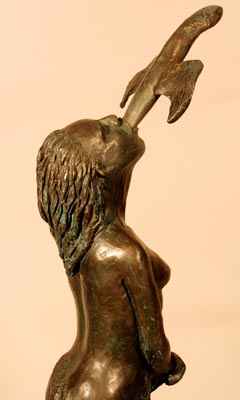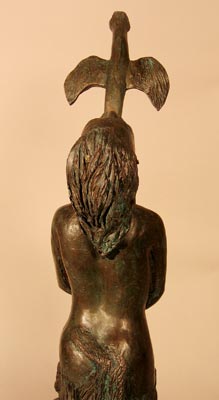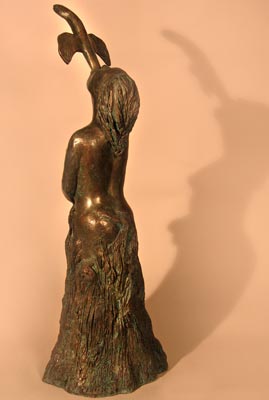Emergence of the Winged Serpent
 “Emergence of the Winged Serpent” is a sculpture project based on dreams that I had in the early 1990s after I had visited the C.G Jung Institute in Kusnacht, Switzerland. I had several dreams in which many, many serpents were emerging from my mouth.
“Emergence of the Winged Serpent” is a sculpture project based on dreams that I had in the early 1990s after I had visited the C.G Jung Institute in Kusnacht, Switzerland. I had several dreams in which many, many serpents were emerging from my mouth.
Jung was in the first dream, and I was lying on a couch in his consultation room. It was as if Jung was alive. I was telling him that I didn’t understand why I had such a profusion of these serpents coming out of my mouth. There was no end to the amount of serpents. I was shocked that I had so many inside me. At first, the serpents were small. As time passed, bigger serpents started coming out of my mouth. They were emerging from a very deep part of me. I had to make a great physical effort to help them come out. I had to push them out because they were so big. Jung was saying, “Well, this is very interesting.” It was as if he understood the phenomenon and was validating my experience, that it was not odd or absurd, that it was a typical, or archetypal, human experience. It seemed that he wanted to comfort me – to reassure me that it was natural for all of these serpents to come out, for they needed some other place to live. They were not supposed to live inside me. They belonged some place else.
At first, I thought that I had to purge the serpents, but then I understood that I was giving them life. All those serpents were energies of creativity. At the time, my ego did not value all of that primal creativity that obviously needed to be expressed.
Eventually, in a later dream, the serpents developed wings. Then I saw the serpents in the air, with wings, flying. In addition, in the dream of winged serpents emerging from my mouth, I noticed that I was a tree-woman. The upper part of my body was a woman, but the lower part of my body was a tree.
 In 1993, I made two sculptures – one of a woman with a serpent coming out her mouth; the other of a tree-woman with a winged serpent coming out her mouth. Those sculptures were displayed in a slide show at a lecture entitled “Animals in Myths and Dreams” presented by a Jungian analyst, Genevieve Geer, at the C.G. Jung Center of Quebec on February 26, 1993. Later, I exhibited the sculptures at the C.G. Jung Foundation of New York in a group show of art works from dream images. More recently, in 2004, I made a new sculpture of the tree-woman with a winged serpent emerging from her mouth.
In 1993, I made two sculptures – one of a woman with a serpent coming out her mouth; the other of a tree-woman with a winged serpent coming out her mouth. Those sculptures were displayed in a slide show at a lecture entitled “Animals in Myths and Dreams” presented by a Jungian analyst, Genevieve Geer, at the C.G. Jung Center of Quebec on February 26, 1993. Later, I exhibited the sculptures at the C.G. Jung Foundation of New York in a group show of art works from dream images. More recently, in 2004, I made a new sculpture of the tree-woman with a winged serpent emerging from her mouth.
Medard Boss presents a case in which a woman experienced snakes and worms “inside her body.” The woman had “the feeling of being bursting full of snakes and worms.” According to Boss, “It was especially her belly that she believed to be infested and riddled with vermiform creatures.” He says that “they began to spread to her breast, to her arms, her legs” (1963: 150). Boss continues: “Finally she was beset by the constant fear that the snakes and worms would at any moment wriggle out of her mouth” (1963: 150-1). He says that eventually “the patient became accessible to the awareness that the reptilian way of living could also have a place in human existence” (1963: 151).
Jung also discusses a case in which a snake emerged from the mouth of a woman. After World War I, a 28-year-old woman consulted Jung. She wanted “to be cured within ten hours” – that is, within only ten analytic sessions. The woman told Jung that “she had a black serpent in her belly.” That was the reason the woman had consulted him, “for she thought that it should be awakened” (1996: 84). The woman was “only intuitive, entirely without a sense of reality.” Then she announced that the snake, which had been dormant, had suddenly become active. “One day she came and said that the serpent in her belly had moved; it had turned around,” Jung says. “Then the serpent moved slowly upward, coming finally out of her mouth, and she saw that the head was golden” (1996: 85).
 In another account of the same case, Jung mentions “a young woman about 27 or 28” who informed him during her initial analytic session that she had a snake in her belly: “Her first words were when I had seated her, ‘You know, doctor, I come to you because I have a snake in my abdomen.'” Jung exclaimed: “What?!” The woman replied: “‘Yes, a snake, a black snake coiled up right in the bottom of my abdomen.'” According to Jung, “I must have made a rather bewildered face at her, for she said, ‘You know, I don’t mean it literally, but I should say it was a snake, a snake.'” In the middle of her analysis, “which lasted only for ten consultations,” the woman told Jung that she had predicted how the analysis would conclude: “‘I’ll come ten times, and then it will be all right.'” How, Jung asked, did she know? “‘Oh,'” she said, “‘I’ve got a hunch.'” When the woman appeared for her fifth or sixth session, she said, ‘Oh, doctor, I must tell you, the snake has risen, it is now about here'” (1977: 309). When she appeared for her tenth session, Jung inquired: “‘Now this is our last consultation. Do you feel cured?'” (1977: 309-10). The woman said: “‘You know, this morning it came up, it came out of my mouth, and the head was golden'” (1977: 310).
In another account of the same case, Jung mentions “a young woman about 27 or 28” who informed him during her initial analytic session that she had a snake in her belly: “Her first words were when I had seated her, ‘You know, doctor, I come to you because I have a snake in my abdomen.'” Jung exclaimed: “What?!” The woman replied: “‘Yes, a snake, a black snake coiled up right in the bottom of my abdomen.'” According to Jung, “I must have made a rather bewildered face at her, for she said, ‘You know, I don’t mean it literally, but I should say it was a snake, a snake.'” In the middle of her analysis, “which lasted only for ten consultations,” the woman told Jung that she had predicted how the analysis would conclude: “‘I’ll come ten times, and then it will be all right.'” How, Jung asked, did she know? “‘Oh,'” she said, “‘I’ve got a hunch.'” When the woman appeared for her fifth or sixth session, she said, ‘Oh, doctor, I must tell you, the snake has risen, it is now about here'” (1977: 309). When she appeared for her tenth session, Jung inquired: “‘Now this is our last consultation. Do you feel cured?'” (1977: 309-10). The woman said: “‘You know, this morning it came up, it came out of my mouth, and the head was golden'” (1977: 310).
Jung amplifies the image of the snake in the abdomen by reference to the serpent in Kundalini Yoga. “I told you,” Jung says, “the case of that intuitive girl who suddenly came out with the statement that she had a black snake in her belly.” He situates the snake in the context of the collective unconscious. “Well now, that is a collective symbol,” he says. “That is not an individual fantasy, it is a collective fantasy.” The image of the snake in the abdomen, Jung says, “is well known in India.” Although the woman “had nothing to do with India” and although the image “is entirely unknown to us,” he says that “we have it too, for we are all similarly human.” When the woman first told Jung about the snake in her belly, he wondered whether “perhaps she was crazy,” but then he realized that “she was only highly intuitive.” She had intuited a typical, or archetypal, image. “In India,” Jung says, “the serpent is at the basis of a whole philosophical system, of Tantrism; it is Kundalini, the Kundalini serpent” (1977: 322). According to Jung, “This is something known only to a few specialists, generally it is not known that we have a serpent in the abdomen” (1977: 322-3).
The Kundalini serpent is coiled quiescently at the base of the spine. When this energy is aroused in the practice of Kundalini Yoga, it uncoils and rises up the spine through six successive chakras, or centers of consciousness. This is what John Woodroffe (also known as Arthur Avalon) calls the “serpent power” (1973). There is, Jung notes, “in Tantric Yoga or Kundalini Yoga an attempt to reach the condition where Shiva is in eternal union with Shakti.” He says that Shiva “is encircled by the female principle, Shakti, in the form of a serpent” (CW 18: 120, par. 263).
References
Boss, M. (1963) Psychoanalysis and Daseinsanalysis, trans. L.B. Lefebre, New York and London: Basic Books.
Jung, C.G. Except as below, all references are to the Collected Works (CW) by volume, page number, and paragraph.
Jung, C.G. (1977) C.G. Jung Speaking: Interviews and Encounters, ed. W. McGuire and R.F.C. Hull, Princeton, NJ: Princeton University Press.
Jung, C.G. (1996) The Psychology of Kundalini Yoga: Notes of the Seminar Given in 1932 by C.G. Jung, ed. S. Shamdasani, Princeton, NJ: Princeton University Press.
Woodroffe, J. (1973) The Serpent Power, Madras: Ganesh & Co.